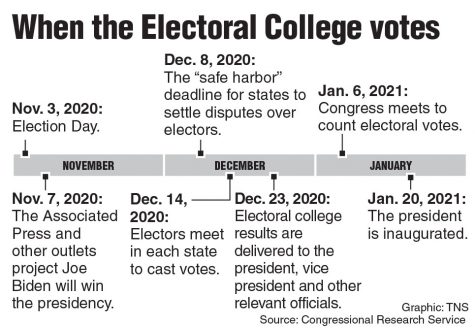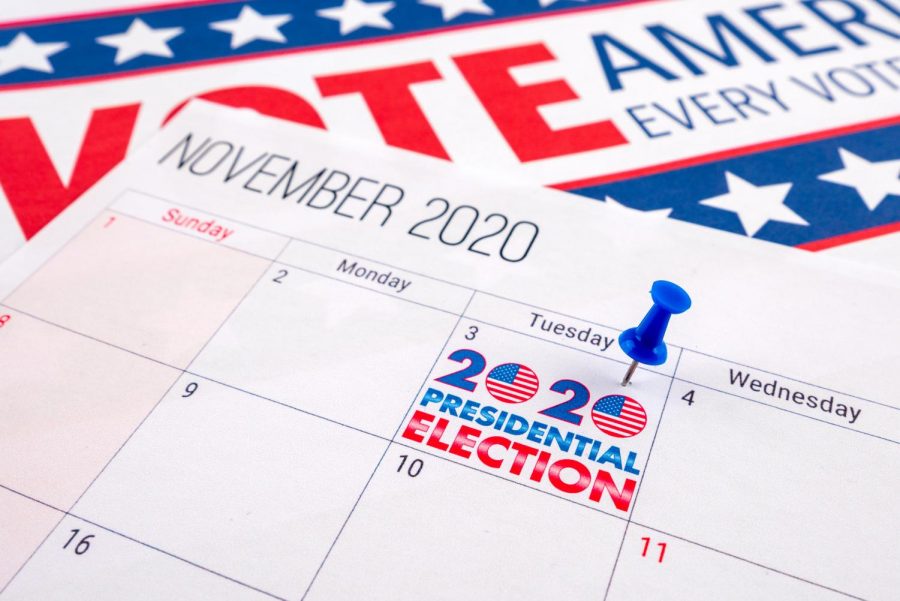The Electoral College: A Biased Institution or the Framework of Democracy?
The Electoral College plays a major role in America’ss democracy and millions of voters will see it at work again on Election Day, Nov. 3. Learn more about the history and inner workings of the Electoral College here.
November 17, 2020
The Electoral College: the system that inevitably decides the presidential election. Not everyone favors it, but it has been the topic of contentious elections, such as the recent 2016 and 2000 elections.
So let’s start at the basics: the Electoral College has 538 electors, and each candidate needs 270 votes to win. The Electoral College has been used since the very first presidential election in 1788, and was put into place when the Constitution was being written, with the goal of ensuring that the election would be decided by the American people. According to the framers of the Constitution, the Electoral College is both about who should select the president, and more importantly, how to divide the votes among the states with varying population differences.
The Electoral College gets complicated from here on out. There are two categories Electoral College votes fall under: the “winner takes all” method and the Congressional district method. Maine and Nebraska are the only states that use the congressional district method, where the popular vote winner in each congressional district receives the district’s electoral votes. The winner from each district is tallied to get the state’s leader. The state winner then revives two senatorial electoral votes. However, the more commonly used method is the winner takes all method, where the winner of all the districts is tallied to get one individual popular vote winner, who gets all the electoral votes.
States with smaller populations, like Wyoming and Alaska, tend to favor the Electoral College due to their belief that it gives them more representation. This is partially true, but far more complicated than you would expect. The Electoral College allows for Wyoming to have 0.18 percent of the total population, but have 0.56 percent of the electoral votes. Each person’s vote counts for 3.04 percent of their state’s total electoral votes, so each person has a bigger say in the election than they would in a larger state, like California, which has 12.05 percent of the United States population, but each vote is 0.85 percent of California’s population. However, California total electoral votes count for 10.22 percent of the total electoral votes. Essentially, this means that in smaller states, each person has a larger say in the winner in their state, but less of a say in the Electoral College as a whole.
Wyoming and California are on the two sides of the extreme, and most states fall between this, with around 0.75 to two percent of the electoral votes, accounting for about 0.50 to 2.18 percent of the country’s total population. The Electoral College seems to favor the states which are have a the smaller size, but are not the smallest states.

This all leads to many claims that a reform of the Electoral College, or even a total abolishment of it, is a crucial measure to take. The abandonment of the Electoral College can only happen through a Constitutional amendment, which requires three-fourths approval of the Senate. This is highly unlikely not happen in the foreseeable future, so the next option is a reform: just as difficult to do in law, but in theory, more states would approve it. For example, one major problem is electors who vote against the party they are representing. This caused the Electoral College vote to be unanimous 97.7 percent of the time, so there is just a 2.3 percent chance the state is not unanimous with the winner of the state.
An answer to the question of reforming the Electoral College is far more complicated and difficult for just one person to answer. The solution would have to be a bipartisan amendment, which seems nearly impossible in this political landscape. According to a recent article, there have been an estimated 200 proposed amendments to reform the Electoral College. These have all been rejected, and the Electoral College remains the same. While the reform of the Electoral College will be a long and difficult process, it is a necessary step to improving our democracy. The Electoral College is here to stay for the foreseeable future. It may be flawed, but it is the best system for our democracy to function.













Susan Anthony • Nov 18, 2020 at 8:12 pm
The National Popular Vote bill is 73% of the way to guaranteeing the majority of Electoral College votes and the presidency to the candidate who receives the most popular votes in the country.
The bill changes state statewide winner-take-all laws (not mentioned in the U.S. Constitution, but later enacted by 48 states), without changing anything in the Constitution, using the built-in method that the Constitution provides for states to make changes.
It requires enacting states with 270 electoral votes to award their electoral votes to the winner of the most national popular votes.
All votes would be valued equally in presidential elections, no matter where voters live.